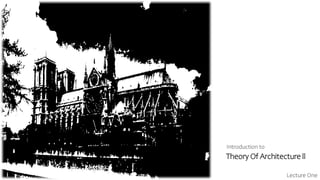
Theory of Arc.pptx
- 1. Theory Of Architecture ll Introduction to Lecture One
- 2. What is Architecture for you? Architecture is what nature can’t do. ( Louis I. Kahn) Architecture is the art of how to waste space (Philip Johnson) Architecture is the art of creating human comfort. ( For me )
- 4. Theory is the analysis of fact. The general or abstract principles of a body of facts, a science or an art. What is Theory Architectural Theory is the act of thinking, discussing and writing about architecture.
- 5. Ideology is a setoff Positive/constructive and realistic attitude Principles/values Forms of activities, and acting's shared by a group of theoreticians Ideology
- 6. The ideology of an individualist the way someone perceives her/himself as a singular subject in the context of her/his society, a subject in a community, the community as a subject, and therefore life itself, nature, and the world as phenomena for the subject. Ideology
- 7. Example Think global design local (Frampton) Regionalism is use of vernacular forms (Frampton) Regionalism bring together the culture and traditions of a country With the realities of growing modern technology (Refat Chadirij)
- 8. Architectural Criticism The expression of disapproval of someone or something on the basis of perceived faults or mistakes The analysis and judgement of the merits and faults of a literary or artistic work.
- 9. 7Principles of Architectural Criticism 1. Fairness in Judgement First, the critic should be a ‘man of principles’. Fairness and clarity are essential when judging a design. The design should be assessed as per its own requirements rather than taking another project as a basis for comparison. A civilian’s house can never be judged along the lines of King’s Palace.
- 10. 7Principles of Architectural Criticism 2. Logical Reasoning The critic should always have a logical reason behind the argument. Emotion doesn't trump reason says Robert Ivy, CEO of the American Institute of Architects The goal behind criticism should never be insulting the architects or their designs, rather it should be pointing out the wrong in order to improve the whole situation
- 11. 7Principles of Architectural Criticism 3. Building a Persuasive Case The art of convincing is very significant to make criticism more constructive. The critics opinion is not of any use if the receiver does not understand it and truly agrees with it. Describing a real life experience as an example to prove a point might help.
- 12. 7Principles of Architectural Criticism 4. Adequate Delivery Sometimes, it is the language that ruins a good critic poor delivery may ruin the effectiveness of a critique, even though the critic is right and has good intentions. Similarly, appropriate delivery may, even, promote an egocentric criticism. The critic should deliver the message in a positive and motivating manner, without hurting the target sentiments The evaluative language like You are wrong or This is a stupid idea may not be of any help whereas I feel like this may be a better solution might just work wonders.
- 13. 7Principles of Architectural Criticism 5. Objective Commentary Criticism should be more objective It should be specific, relevant, and to the point. Focusing on the problem at hand helps in understanding the context Your design lacks this is anytime better than Something isn't right but I am unable to put it.
- 14. 7Principles of Architectural Criticism 6. General Knowledge of Architecture Awareness of the past, present, and possible future issues and trends of architecture is a genuine requirement for a critic to be capable of commenting on an architectural design. Also, experience as a practicing architect can be very advantageous.
- 15. 7Principles of Architectural Criticism 7. Understanding the Architects Point of View Lastly, its essential for critics to put themselves in the shoes of the receiving architects in order to adjudicate the design properly Doing this will enable them to understand the problem from the architects point of view and hence deliver more appropriate suggestions
- 16. Thank You